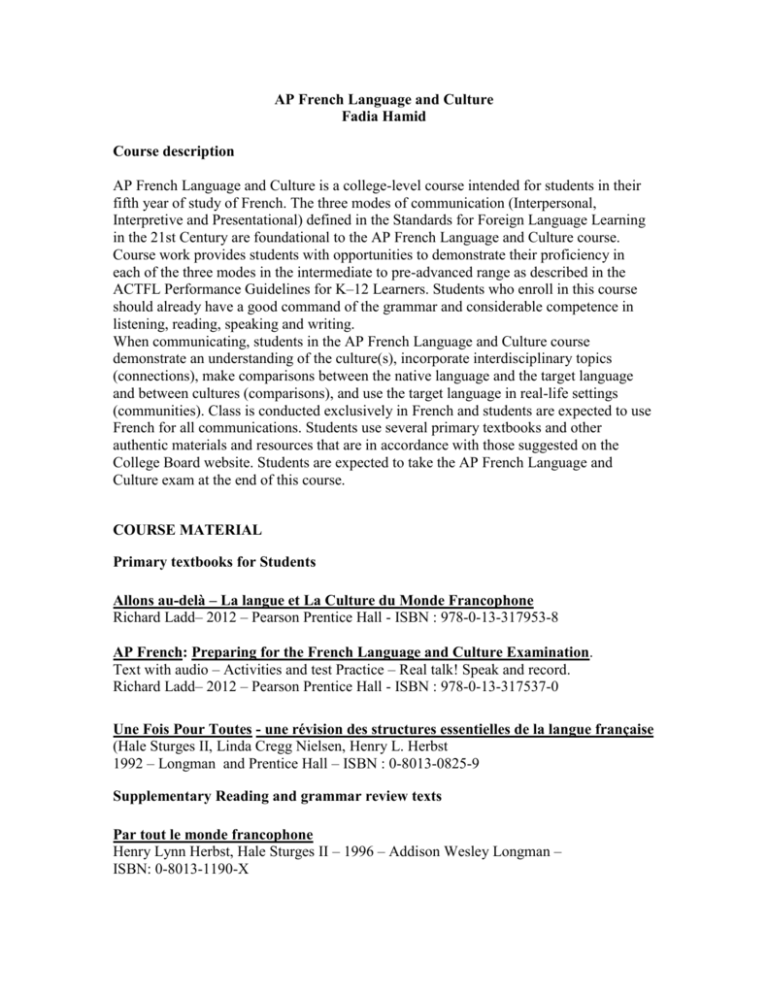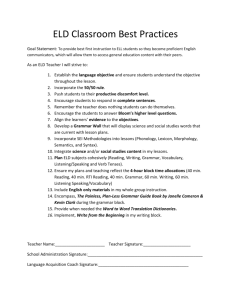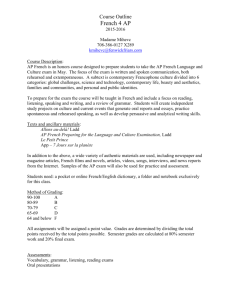
AP French Language and Culture
Fadia Hamid
Course description
AP French Language and Culture is a college-level course intended for students in their
fifth year of study of French. The three modes of communication (Interpersonal,
Interpretive and Presentational) defined in the Standards for Foreign Language Learning
in the 21st Century are foundational to the AP French Language and Culture course.
Course work provides students with opportunities to demonstrate their proficiency in
each of the three modes in the intermediate to pre-advanced range as described in the
ACTFL Performance Guidelines for K–12 Learners. Students who enroll in this course
should already have a good command of the grammar and considerable competence in
listening, reading, speaking and writing.
When communicating, students in the AP French Language and Culture course
demonstrate an understanding of the culture(s), incorporate interdisciplinary topics
(connections), make comparisons between the native language and the target language
and between cultures (comparisons), and use the target language in real-life settings
(communities). Class is conducted exclusively in French and students are expected to use
French for all communications. Students use several primary textbooks and other
authentic materials and resources that are in accordance with those suggested on the
College Board website. Students are expected to take the AP French Language and
Culture exam at the end of this course.
COURSE MATERIAL
Primary textbooks for Students
Allons au-delà – La langue et La Culture du Monde Francophone
Richard Ladd– 2012 – Pearson Prentice Hall - ISBN : 978-0-13-317953-8
AP French: Preparing for the French Language and Culture Examination.
Text with audio – Activities and test Practice – Real talk! Speak and record.
Richard Ladd– 2012 – Pearson Prentice Hall - ISBN : 978-0-13-317537-0
Une Fois Pour Toutes - une révision des structures essentielles de la langue française
(Hale Sturges II, Linda Cregg Nielsen, Henry L. Herbst
1992 – Longman and Prentice Hall – ISBN : 0-8013-0825-9
Supplementary Reading and grammar review texts
Par tout le monde francophone
Henry Lynn Herbst, Hale Sturges II – 1996 – Addison Wesley Longman –
ISBN: 0-8013-1190-X
Ensemble littérature – sixième edition.
Raymond F. Comeau, Normand J. Lamoureux – 1999 – Holt, Rinehart and Winston –
Harcourt Brace College Publishers – ISBN: 0-03-022248-6
501 French Verbs
Christopher Kendris and Theodore Kendris – 2007 – Barron’s –
ISBN: 978-0-7641-3554-5
Imaginez, le français sans frontières
Mitschke – 2012 – Vista Higher Learning – ISBN: 978-1-60576-886-1
Une si longue lettre
Mariama Bâ – Les nouvelles éditions africaines
Un papillon dans la cité
Gisèle Pineau – Editions Sépia
Other resources and internet sites for Reading and listening
Articles and informational graphs and charts from French newspapers and
magazines internet sites such as le Monde, Libération, l’Internaute, le Figaro to
name a few.
YouTube sites for French or Francophone songs relevant to the six themes
AATF – YouTube site
www.TV5.org
http://www.geoado.com/
http://www.jde.fr/
http://www.polarfle.com/crime/crimeavance.htm
http://www.vanin-methodes.be/
http://www.lamediatheque.be/
http://pointculture.be/
http://www.canalacademie.com/
http://fr.ekopedia.org/
http://1jour1actu.com/
http://www.france2.fr/
www.rtbf.be
http://franceinfo.radio.fr/
http://onethinginafrenchday.podbean.com/
http://culturebox.francetvinfo.fr/
http://www.lesfables.fr/
http://ici.radio-canada.ca/tele/
Assessment
Oral performance – based on regular informal in-class participation along with
interpersonal speaking assessments and oral presentations on cultural topics, graded using
the AP scoring guidelines
Written performance – based on in-class essays and interpersonal writing assignments,
graded using the AP scoring guidelines.
Reading and listening performance – based on both informal comprehension and formal
multiple-choice passages in the format of the AP exam.
Teaching Strategies
A total immersion in French environment lays the groundwork for the four skills
(listening, speaking, reading and writing) that are embedded in weekly activities. I try to
promote a student-centered classroom where the emphasis is on communication to help
students reach higher levels of proficiency. Students receive a syllabus on the first day of
the week that outlines the activities in class and describes homework. While activities
vary from week to week, certain assignments and assessments are scheduled regularly,
usually every week or two. These include thematic vocabulary quizzes and in-class
essays that are evaluated using the AP French Language rubric. As often as possible,
every activity is designed to incorporate all four skills. :
To reach higher levels of proficiency in listening:
Our class is completely conducted in French and students use only French with me and
with one another within the classroom. Every other week, a student chooses a French
thematically based song, brings it to class along with a vocabulary list of new words and
a cloze activity for the rest of the students to complete. Every other year we go on a trip
to France that includes a home stay with a French family. This allows students to use
French in real-life situations and build friendships and connections with French families.
Furthermore, it is an excellent opportunity for them to practice using French in emails, on
Face book and other social media venues before and after the trip. Throughout the year,
students complete formal assignments that require them to bring in a video or podcast on
current events, give a resume about it and be ready to answer questions regarding the
news. This can be from any of the websites on the syllabus or one of their choice. In
addition, they listen to the podcasts and sound bits associated with the readings in Allons
au-delà, watch French films in class and at the International film festival that takes place
in our city every year.. These are followed by lively class discussions about the themes of
each film and a comparison of the arts in the United States and France or the francophone
world.
To reach higher levels of proficiency in speaking:
Since French is de rigueur in our classroom, participation is expected in class
discussions. Students also engage in class discussions and debates about the themes being
studied or current events. Students are regularly given speaking prompts and they record
their answer digitally. The prompts are usually based on the theme being studied or on a
special current event in the community. Their responses are evaluated using the AP
Speaking rubric, which they receive at the beginning of the year. Students receive
feedback with comments and corrections. In other speaking activities students bring
pictures from magazines, advertisements, etc. (or find them online) and are required to
describe, hypothesize, and ask and answer questions about them. They are also assigned
weekly presentations, to practice both speaking and listening presentational modes. For
example they may be asked to talk about a painting of their choice by a French or
francophone artist and provide information about the artist and explain why they chose it.
To reach higher levels of proficiency in reading:
The course prepares students to use the French language in real-life settings.
Therefore, texts are drawn from a variety of authentic sources including francophone
literary excerpts representing different genres, francophone newspapers and magazines
from the Internet as well as novels and anthologies. Students also are assigned the short
excerpts with multiple-choice questions from released AP exams as well as the ones from
their texts. They are expected to support and justify their answers by referencing the text.
Students typically receive participation points for this kind of activity. Assessments vary
depending on the type of reading involved. For example, getting the gist is the most
important criteria associated with reading magazine and newspaper articles. In more
intensive reading assignments, typically literary readings, students need to understand
linguistic as well as semantic detail and pay closer attention to the text. Follow-up
exercises may include dictations from the text, true and false questions or short
responses, group discussion of theme, and reflection on the ideas in the text and how it
relates to their own knowledge and experience. A short writing assignment often follows
such discussions.
To reach higher levels of proficiency in writing:
Students have writing tasks assigned to them at least twice a week for homework. Often
these involve answering questions based on a literary reading assignment or writing a
short reaction to a theme treated in a reading. For magazine or newspaper articles, they
answer questions regarding the main ideas, define new vocabulary words in French and
write a reaction to the article. They also keep a journal about topics that vary from
personal events to current events articles. I check them weekly and grade them only for
completion. However, the journals are often used as a springboard to discuss use of
grammar structures, vocabulary and useful expressions. Every other week students have
an in-class writing assignment related to the theme being studied or to current events.
During the first semester, students are allowed to use dictionaries or vocabularies lists
and have the 50 minutes class period to complete it. However, starting with the second
semester, students are no longer allowed to use any resources and the essays are timed
modeling the AP exam. When I first correct their writing, I include comments on the
strength of the essay and indicate areas that need improvement. They have to rewrite the
essays making all necessary corrections. This strategy makes them more aware of the
areas where they are strong and those they need to improve. All writing is graded based
on the AP rubric. In addition, students examine samples of writing of all levels that are
available on the AP website and students assess them to compare their evaluation to that
of the actual ones given by AP correctors. This serves as an opportunity to help students
avoid certain errors and improve their writing.
General guide to thematic units
(Note: “Activities” may include journaling, interactive exercises; oral and written
presentations; the use of discussion boards on GoogleClassroom; and the use of social
networking to communicate with students from France)
August/September
(25 days)
Contemporary life and education
• Study vocabulary associated with schools, learning and
subjects.
• Read, discuss and react in writing to excerpts from L’Enfant
Noir (Camara Laye).
• Read, discuss and react to excerpts from Un papillon dans la
cité (Gisèle Pineau).
• Read about the French education system:
http://www.education.gouv.fr/
• Based on above and other shorter texts about educational
issues, work in groups to create a presentation that compares
different aspects of the French and American school systems.
• Complete listening and Internet activities from
7 Jours sur la Planète that correspond to education and other
contemporary issues in the francophone world.
• Keep an interactive journal noting linguistic differences
between French and English.
• Grammar review: possessive pronouns, present tense and
imperative.
• Writing assignment incorporating above grammar and
addressing contemporary life and education.
September /October
(25 days)
Unit 2- Families and Communities
• Study vocabulary associated with family and relationships.
• Read and discuss excerpts from Une si longue lettre
(Mariama Bâ)
• Compare and contrast family structures in the US with those
in francophone countries.
• Watch, discuss and react orally to a video on La piece
montée http://www.dailymotion.com/video/xch6g9_piecemontee-bande-annonce_shortfilms#.UQFdE_LFl2A
• Participate in a debate about the changing roles of families.
• Read entries about children’s lives from the site 24 heures
de la vie d’un enfant and compare to their own childhood (inclass group discussion and in writing on digital discussion
board)
• Grammar review: past tenses; prepositions; conjunctions.
• Writing assignment incorporating above grammar and
addressing families and communities.
November/December
(25 days)
Unit 3-Personal and Public Identities
• Study vocabulary associated with immigration, nationalism
and patriotism.
• View excerpts concerning “multiculturalism” from the film:
Paris je t’aime.
• Read and discuss Beni ou le paradis privé (Azouz Bégag)
and La dernière classe (Alphonse Daudet)
• Song (discussion and activities): Ma France à moi (Diam’s).
• Read and discuss Aux Champs (Guy de Maupassant)
• Grammar review: subjunctive and relative pronouns.
• Write a blog entry comparing and contrasting the conception
of public identity in French and francophone countries with
that in the United States and react to posts from other
students.
• Writing assignment incorporating above grammar and
addressing personal and public identity.
January/February
(25 days)
Unit 4 - Global Challenges: Environment
• Study vocabulary associated with nature and environment.
• Read and discuss L’Homme qui plantait les arbres (Giono).
• View and discuss film L’homme qui plantait des arbres.
• Song (discussion and activities): Aux Arbres Citoyens
(Yannick Noah).
• Read, discuss and react in writing to article from “Internet
Actuel” (L’homme le plus grand ennemi de la planète).
• Read and discuss the poem Soyez polis (Jacques Prévert)
• Complete listening and Internet activities from 7Jours sur la
Planète that correspond to the environment.
• Grammar review: future, conditional and si clauses
• Writing assignment incorporating above grammar and
addressing global challenges.
February/March
(25 days)
Unit 5- Science and Technology
• Study vocabulary associated with technology and social
networking.
• Read and discuss La fin des livres (Albert Robida and
Octave Uzanne)
• Listen to, discuss, and complete activities about : Internet et
le piratage, Le téléphone portable, and Les roseaux sociaux
(on canalacademie Internet site)
• Activities using French abbreviations for SMS
(French.about.com)
• Write a blog entry addressing how the use of social
networking is changing the world, and react to posts from
other students.
• Grammar review: Si clauses and associated tenses
• Writing assignment incorporating above grammar and
addressing science and technology.
April
(15 days)
Unit 6 - Beauty and Aesthetics
• Study vocabulary associated with Beauty and aesthetics
• Read and discuss articles and watch videos from
http://culturebox.francetvinfo.fr/
• Listen to, discuss and complete activities on Les trésors
intimes de Monet and La fondation Zinsou on canalacademie
site.
• Oral presentations by students about a painting of their
choice including an explanation about the style of painting
and reasons they chose it.
• Read and discuss Le corbeau et le renard and Le lièvre et la
tortue (La Fontaine)
• Read and discuss the poem Il pleure dans mon Coeur
(Verlaine)
• Complete listening and Internet activities from 7jours sur la
Planète that correspond to art, beauty and aesthetics.
• Add to their interactive journal re: linguistic differences.
• Grammar review: possessive and demonstrative adjectives;
descriptive adjectives and adjective agreement.
• Writing assignment incorporating above grammar and
addressing beauty and aesthetics.
Grading
Students will be graded on the following:
Weekly grammar and vocabulary quizzes
Weekly class presentations
Homework assignments
In-class writing
Class discussions
End of semester and end of year assessments
AP French Language and Culture Exam Format
Section
Number of
Questions
Percent of
Final Score
Approx. 95
minutes
Section I: Multiple Choice
Part A
Interpretive Communication:
Print Texts
Approx. 40
minutes
30 questions
Interpretive Communication:
Print and Audio Texts (combined)
Part B
Time
50%
Approx. 55
minutes
35 questions
Interpretive Communication:
Audio Texts
Approx. 85
minutes
Section II: Free Response
Interpersonal Writing: E-mail Reply
1 prompt
15 minutes
Presentational Writing: Persuasive Essay
1 prompt
Approx. 55
minutes
Interpersonal Speaking: Conversation
5 prompts
20 seconds
for each
response
Presentational Speaking: Cultural comparison
1 prompt
2 minutes to
respond
50%









